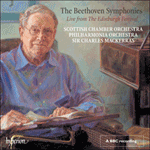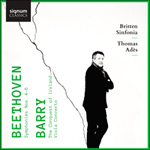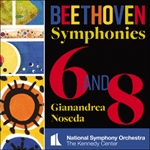
Welcome to Hyperion Records, a British classical label devoted to presenting high-quality recordings of music of all styles and from all periods from the twelfth century to the twenty-first.
Hyperion offers both CDs, and downloads in a number of formats. The site is also available in several languages.
Please use the dropdown buttons to set your preferred options, or use the checkbox to accept the defaults.

The ‘Pastoral’ Symphony is a work that proceeds in large waves of sound, with the pace of harmonic change deliberately unhurried, even in developmental sections, and with very little use of the minor. As a consequence of Beethoven’s broad brush-strokes, and to avoid repetition on a large scale, the reprises and recapitulations during the course of the work are elaborately varied; and in this scheme of things the function of the storm is to provide a much-needed source of symphonic tension.
Almost everything in the broadly paced opening movement derives from its initial halting violin phrases, played above a rustic, drone-like bare fifth on violins and cellos. Only the principal second subject, presented in the form of a gradual textural crescendo, provides any real thematic contrast, though even this is short-lived. In the coda the village-band takes over, in the shape of a clarinet solo with a ‘rocking’ bassoon accompaniment.
Just as the opening movement is largely bereft of dramatic incident, so the gently undulating sound of the stream runs almost uninterruptedly through the slow movement. Towards the end, the gurgling of the water pauses for a moment while Beethoven introduces the sounds of nightingale, quail and cuckoo, as portrayed by flute, oboe and clarinets, respectively. Those more literal descriptions of individual bird-calls had been anticipated in the main body of the piece—not least, by the violin trills and ‘chirping’ repeated notes at the approach to the recapitulation.
The scherzo and trio are through-composed—so much so that it is difficult to define where one section ends and the next begins. What we may perceive as the trio is the charmingly syncopated oboe melody, with a bassoon accompaniment restricted throughout to only three notes, as though the rustic player from the coda of the first movement were putting in another appearance. Just as Beethoven seems on the verge of bringing back the scherzo, the pace accelerates, the metre changes, and he introduces instead a ‘stamping’ dance conjuring up a Breughelesque vision of peasants making merry. During the final reprise of the scherzo, the revelries become more frenzied, until at their climax the music is interrupted in dramatic fashion by the sound of the approaching storm.
Beethoven’s masterstroke is to begin his storm pianissimo, with a sense of pent-up tension, before the thunder unleashes its violence in earnest. Twice the storm approaches and recedes, with the shrill sound of the piccolo adding pungency to the second climax. As the rumble of thunder at last dies away, the ‘raindrop’ patter of the second violins’ opening bars is transmuted into a broad hymn-like phrase in the major—an offering of thanksgiving, before a gentle rising scale on the flute leads directly into the finale.
The flute’s scale lands the music firmly on the key of C major, and it is in that key that the clarinet gives out a preliminary version of the finale’s main theme, while the violas provide a pastoral drone on their two lowest open strings. As the clarinet’s melody is taken over by the horn, Beethoven superimposes a second drone effect on the cellos, this time anchored on the home note of F. As a result, dominant and tonic harmonies are momentarily sounded together, producing an effect which sets the finale in motion in an atmosphere of rustic charm. The entire symphony, indeed, is one that seems to grow upwards, from its bass-line; and not for nothing does an early sketch for the slow movement, bearing the title of Murmeln der Bäche (‘Murmuring of the brooks’), contain the remark: ‘The bigger the brook, the deeper the sound.’
from notes by Misha Donat © 2007
La Symphonie «Pastorale» est une œuvre qui procède par larges vagues sonores, avec un changement harmonique délibérément paisible, même dans les sections de développement, et avec un recours rarissime au mode mineur. Conséquence de ces grands coups de pinceau beethovéniens—et pour éviter toute répétition à grande échelle—, les reprises et les réexpositions sont constamment variées avec recherche; et, dans ce schéma, la tempête est là pour fournir une fort nécessaire source de tension symphonique.
Presque tout dans le mouvement d’ouverture, qui progresse à grandes enjambées, dérive des premières phrases violonistiques heurtées, jouées par-dessus une rustique quinte dépouillée, de type bourdon, aux violons et aux violoncelles. Seul le deuxième sujet principal, présenté sous les traits d’un crescendo de texture, apporte un véritable, mais bien éphémère, contraste thématique. Dans la coda, la fanfare villageoise prend le pouvoir, incarnée par une clarinette solo accompagnée d’un basson «berçant».
À l’image du mouvement d’ouverture largement dénué d’incidents dramatiques, la sonorité doucement ondoyante du ruisseau baigne presque tout le mouvement lent. Vers la fin, le murmure de l’eau s’interrompt pour permettre à Beethoven d’introduire les chants du rossignol, de la caille et du coucou (la flûte, le hautbois et les clarinettes). Ces évocations plus littérales de chants d’oiseaux singuliers, le corps principal de la pièce les avait anticipées, notamment par les trilles violonistiques et les notes répétées «gazouillantes» à l’approche de la réexposition.
Le scherzo et le trio sont durchkomponiert, si bien qu’on peine à dire où s’arrête une section et où commence la suivante. Ce que nous pourrions prendre pour le trio est la mélodie de hautbois délicieusement syncopée, avec un accompagnement de basson constamment limité à trois notes, comme si le joueur rustique de la coda du premier mouvement était de retour. Alors même que Beethoven semble s’apprêter à ramener le scherzo, l’allure s’accélère, le mètre change et c’est une danse «trépignante» qui survient, évocation bruegelesque de réjouissances paysannes. Durant la reprise finale du scherzo, les festivités, toujours plus frénétiques, voient leur apogée dramatiquement interrompu par la tempête qui approche.
Le coup de génie de Beethoven, c’est de commencer sa tempête piainissimo, avec une sensation de tension refoulée, avant que l’orage ne libère sa violence pour de bon. Par deux fois, la tempête approche et s’éloigne, la stridence du piccolo ajoutant de la causticité au second apogée. Quand le grondement du tonnerre cesse enfin, les «gouttes de pluie» des mesures d’ouverture des seconds violons sont transmuées en une vaste phrase hymnique, en majeur—une offrande d’action de grâces, avant qu’une douce gamme ascendante à la flûte ne mène directement au finale.
La gamme de la flûte fait retomber la musique sur un solide ut majeur, et c’est dans cette tonalité que la clarinette énonce une version préliminaire du thème principal du finale, cependant que les altos servent un bourdon pastoral sur leurs deux plus graves cordes à vide. Lorsque la mélodie de la clarinette est reprise par le cor, Beethoven surimpose un second effet de bourdon aux violoncelles, un effet ancré cette fois sur la note principale de fa. Résultat: les harmonies de dominante et de tonique sont momentanément simultanées, d’où un finale qui se met en branle dans une ambiance au charme champêtre. La symphonie tout entière paraît vraiment pousser à partir de sa ligne de basse; et ce ne fut pas innocemment que Beethoven nota sur une des premières esquisses de son mouvement lent: «Plus large est le ruisseau, plus profond est le son.»
extrait des notes rédigées par Misha Donat © 2007
Français: Hypérion
Die Pastoralsinfonie entfaltet sich in großen Klangwellen in einem bewusst gemächlichen Tempo harmonischer Fortschreitungen (sogar in den Durchführungsabschnitten) und einem sehr begrenzten Einsatz von Moll. Wegen Beethovens breiten Pinselstrichen und zur Vermeidung von Wiederholungen größeren Ausmaßes wurden die Reprisen und Wiederholungen, wo sie im Verlauf des Werkes auftauchen, ausführlich variiert, und in diesem Konzept fungiert das Unwetter als eine sehr notwendige Quelle sinfonischer Spannung.
Fast alles in dem bedächtig fortschreitenden Eröffnungssatz beruht auf den am Anfang zu hörenden zögernden Violinphrasen, die über einer rustikalen, orgelpunktähnlichen Quinte in den Violinen und Violoncelli erklingen. Einen richtigen thematischen Kontrast liefert nur das eigentliche zweite Thema, das sich in Form eines allmählich lauter werdenden Stimmenzuwachses präsentiert. Aber selbst das ist kurzlebig. In der Koda übernehmen die Dorfmusikanten die Führung vermittels eines Klarinettensolos mit „wiegender“ Fagottbegleitung.
Genau wie der erste Satz im Großen und Ganzen ohne dramatische Einbrüche verläuft, fließt auch der sanft wallende Klang des Baches fast ununterbrochen durch den langsamen Satz. Gegen Ende hält das Gurgeln des Wassers für einen Moment inne, und Beethoven ahmt mit Flöte, Oboe und Klarinetten die entsprechenden Rufe einer Nachtigall, Wachtel und eines Kuckucks nach. Diese naturalistischeren Nachahmungen einzelner Vogelrufe wurden schon im Hauptteil des Stückes vorweggenommen—nicht zuletzt durch die Violintriller und „zwitschernden“ Tonwiederholungen vor Beginn der Reprise.
Das Scherzo einschließlich Trio ist durchkomponiert—und das so gründlich, dass man nur mit Schwierigkeit sagen kann, wo der eine Abschnitt aufhört und der nächste beginnt. Als Trio kann man womöglich die charmant synkopierte Oboenmelodie bezeichnen, deren Fagottbegleitung durchgängig auf nur drei Noten beschränkt ist und den Eindruck erweckt, als hätten die Dorfmusikanten aus der Koda des ersten Satzes einen weiteren Auftritt. Just in dem Moment, wenn Beethoven den A-Teil des Scherzos wieder aufzunehmen scheint, beschleunigt sich das Tempo und die Taktart ändert sich. Statt des A-Teils beginnt Beethoven mit einem stampfenden Tanz und beschört so eine an Breughel mahnende Vision von Bauern auf einem Fest. Bei der letzten Wiederholung des A-Teils werden die Träumereien frenetischer und steigern sich zu einem Höhepunkt, auf dem die Musik dramatisch vom Klang des herannahenden Gewitters unterbrochen wird.
Mit einem Geniestreich beginnt Beethoven sein Unwetter im pianissimo und schafft so ein Gefühl angestauter Spannung. Dann entfesselt der Donner ernsthaft seine Gewalt. Zweimal nähert sich das Gewitter und zieht sich wieder zurück, wobei der schrille Klang der Piccoloflöte den zweiten Höhepunkt noch zusätzlich schärft. Wenn das Donnergrollen endlich vorbei ist, verwandelt sich das Prasseln der Regentropfen aus den ersten Takten der zweiten Violinen in eine breite hymnische Phrase in Dur—eine Dankesgabe—worauf eine sanft aufsteigende Flötentonleiter direkt zum Schlusssatz überleitet.
Die Flötentonleiter verankert die Musik fest in der Tonart C-Dur, und in dieser Tonart artikuliert die Klarinette eine Vorfassung des Hauptthemas des Schlusssatzes, während die Bratschen einen pastoralen Orgelpunkt auf ihren zwei tiefsten leeren Saiten beisteuern. Wenn das Horn die Klarinettenmelodie übernimmt, legt Beethoven einen zweiten, diesmal auf dem Grundton F verankerten Orgelpunkt in den Violoncelli darzu. Demzufolge erklingen Dominant- und Tonikaharmonien zeitweilig zusammen und schaffen damit die Voraussetzungen für die Ingangsetzung des Schlusssatzes in einer Atmosphäre rustikalen Charmes. Tatsächlich scheint die ganze Sinfonie von der Basslinie nach oben zu streben. Nicht umsonst enthält eine frühe Skizze für den langsamen Satz, die den Titel „Murmeln der Bäche“ enthält, den Hinweis: „Je grösser der Bach je tiefer der Ton.“
aus dem Begleittext von Misha Donat © 2007
Deutsch: Elke Hockings
 Beethoven: Symphonies Beethoven: Symphonies‘Hyperion's set is that early evening Beethoven cycle caught in recordings of remarkable intimacy and focus … it is a set I would happily put int ... ‘So magnificently exhilharating an account’ (BBC Music Magazine)» More |
 Beethoven: Symphonies Nos 4, 5 & 6 Beethoven: Symphonies Nos 4, 5 & 6Impeccable performances of Beethoven's middle three symphonies are here presented alongside Gerald Barry's enterprising viola concerto (with soloist Lawrence Power) and the extreme cantata 'The Conquest of Ireland' (bass Joshua Bloom and a text by ...» More |
 Beethoven: Symphonies Nos 6 & 8 Beethoven: Symphonies Nos 6 & 8Two of Beethoven's most popular symphonies—the 'Pastoral' No 6 and No 8 with its trademark combination of humour and seriousness—in taut performances from the NSO and Music Director Gianandrea Noseda.» More |

